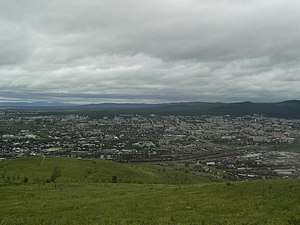Transbaikal,Trans-Baikal,Transbaikalia(Russian:Забайка́лье,romanized:Zabaykal'ye,IPA:[zəbɐjˈkalʲjɪ]), orDauria(Даурия,Dauriya) is a mountainous region to the east of or "beyond" (trans-)Lake BaikalinFar Eastern Russia.

The steppe and wetland landscapes of Dauria are protected by theDaurian Nature Reserve,which forms part of aWorld Heritage Sitenamed "Landscapes of Dauria".
Geography
editDauria stretches for almost 1,000 km from north to south from thePatom PlateauandNorth Baikal Plateauto the Russian state borders withMongoliaand China. The Transbaikal region covers more than 1,000 km from west to east from Lake Baikal to themeridianof the confluence of theShilkaandArgunRivers. To the west and north lies theIrkutsk Oblast;to the north theRepublic of Sakha(Yakutia), to the east theAmur Oblast. Oktyabrsky(Октябрьский) village,Amur Oblast,near the Russia-China border is a large site of uranium mining and processing facilities.[1]
Part of the area is protected by theDauria Nature Reserve.[2]
Fauna and flora
editThe region has given its name to various animal species includingDaurian hedgehog,and the following birds:Asian brown flycatcher(Muscicapa daurica),Daurian jackdaw,Daurian partridge,Daurian redstart,Daurian starling,Daurian shrikeand thered-rumped swallow(Hirundo daurica). TheMongolian wild ass(Equus hemionus hemionus) is extinct in the region.
The common name of the famousDahurian larch(Larix gmelinii) as well as that of theDahurian buckthorn(Rhamnus davurica) are also derived from the same source.
History
editThe ancient proto-MongolSlab Grave Cultureoccupied the area aroundLake Baikalin the Transbaikal territory.[3]
In 1667,Gantimuropened Transbaikalia and the country on theAmur Riverto the influence of theTsardom of Russia.[citation needed]
InImperial Russia,Dauria itself became anoblast- theTransbaikal Oblast(Russian:Забайкальская область), established in 1851, with its capital atNerchinsk,then atChita.It became part of the short-livedFar Eastern Republicbetween 1920 and 1922.
The administration of historic Transbaikalia currently[update]includesBuryatiaand theZabaykalsky Krai;the area makes up nearly all of the territory of these twofederal subjects.
See also
editReferences
edit- ^Shandala N, Filonova A, Titov A, Isaev D, Seregin V, Semenova V, and Metlyaev EG (2009),Radiation situation nearby the uranium mining facility,Environmental section poster P.9, 54th Annual Meeting of the Health Physics Society, 12–16 July 2009, Minneapolis, MN, USA.
- ^"The exhibition" Iris Russia "".flower-iris.ru.Retrieved23 January2015.
- ^ History of Mongolia, Volume I, 2003.
- Kropotkin, Peter Alexeivitch(1888)..Encyclopædia Britannica.Vol. 23 (9th ed.). pp. 509–511.
- Kropotkin, Peter;Bealby, John Thomas (1911)..InChisholm, Hugh(ed.).Encyclopædia Britannica.Vol. 27 (11th ed.). Cambridge University Press. pp. 169–170.